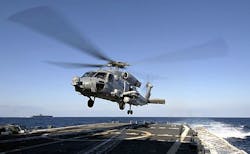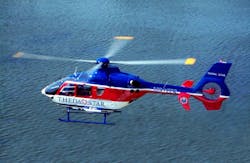Avionics Intelligence casts a spotlight on helicopter avionics and their adoption to increase safety and reduce accidents.
U.S. Navy looks to L-3 Communications for over-the-horizon situational awareness
U.S. Navy helicopter avionics experts needed a digital data link to enable helicopters to share sensor information in real time with Navy and Coast Guard surface ships. They found their solution from L-3 Communications-West in Salt Lake City.
Officials of the Naval Air Systems Command at Patuxent River Naval Air Station, Md., announced a $6.7 million contract modification Tuesday to L-3 to provide four Common Data Link Hawklink AN/SRQ-4 radio terminal sets for the Navy and one for the U.S. Coast Guard.
The AN/SRQ-4 is the shipboard element of a system that links the MH-60R helicopter with surface warships in the area. It provides command and control (C2), sensor data transfer, data link operation, and built-in-test.
The system provides real-time use of aircraft sensors to extend situational awareness over the horizon by enabling surveillance helicopters to data-link radar, video, networking, and acoustic data to Navy Arleigh Burke-class destroyers, Ticonderoga-class cruisers, and Perry-class frigates. Its control systems run on modern open-systems architectures, L-3 officials say.
The AN/SRQ-4 supports anti-submarine warfare (ASW) and anti-ship surveillance and targeting (ASST) missions; receives and distributes full-motion video; is IP-enabled and built to work with future network-centric applications; is compatible with the SAU7000 digital messaging interface; and has ruggedized construction and modules that are qualified to Navy shock and environmental standards.
Eurocopter selects Sandel Avionics for EC135 Helicopters Mid-Life Efficiency Package
Eurocopter engineers sought quality displays for the company’s Mid-life Efficiency Package (MEP) for new production EC135 model helicopters. They found their solution at Sandel Avionics Inc., a global provider of compact, integrated display systems technologies in Vista, Calif.
SN4500 Primary Navigation Displays and SA4550 Primary Attitude Displays from Sandel Avionics are listed as optional equipment on Eurocopter EC135 helicopters in the company’s Blue Book.
The Eurocopter EC135 is a popular twin-engine helicopter platform for law-enforcement, ambulance, search-and-rescue, and first-responder applications.
“OEMs and aftermarket customers alike continue to look to Sandel for avionics that are proven and bring value for the end-user,” says Sandel President and CEO Gerry Block.
Designed to ease pilot workload and make flying safer, the Sandel SA4550 Primary Attitude Display features LED-backlit technology and provides pilots with ease of use, intuitive pilot controls, single- or dual-cue display options, and high visibility, even in bright sunlight conditions.
The Sandel SN4500 Primary Navigation Display features the same high-visibility display technology with added functionality and enhanced safety via traffic and datalink weather interfaces.
U.S. Army selects UTC Aerospace to protect helicopters from anti-aircraft weapons using lasers
U.S. Army aviation experts needed a laser-detection system to help protect helicopters from anti-aircraft weapons that use laser rangefinders, laser designators, and blinding lasers. They found their solution from the UTC Aerospace Systems ISR Systems segment in Danbury, Conn.
Officials of the Army Contracting Command at Redstone Arsenal, Ala., announced a $208.5 million multi-year contract to UTC Aerospace Monday for Army/Navy Piloted Aircraft/Visual and Visible Light/Receiving, Passive Detecting (AN/AVR-2B) Laser Detecting Sets (LDS).
The AN/AVR-2 LDS helicopter avionics system is a passive laser warning system that receives, processes, and displays threat information when the helicopter is illuminated by lasers to enable the flight crew to take evasive action.
Short-range air-defense missiles and anti-aircraft artillery typically use laser guidance. The LDS displays threat information on the AN/APR-39A(V)1 radar detecting set indicator in the cockpit. The system has an interface unit comparator and four identical sensor units.
The helicopters that can carry the AN/AVR-2 LDS include the U.S. Marine Corps AH-1F Cobra gunship, the Army AH-64 Apache attack helicopter, the Army MH-60K and EH-60A Black Hawk helicopters, the MH-47E heavy-lift helicopter, and the OH-58D Kiowa armed reconnaissance helicopter.
The AN/AVS-2B(V) version of the LDS was derived from technology developed for the cancelled RAH-66 Comanche program. The system is reported to be 40 percent smaller, 45 percent lighter, and to use 45 percent less power than the previous AN/AVR-2A(V) version.
The system provides increased capability for threat detection and data interface and has demonstrated a 500 percent improvement in reliability. The model was introduced into service in 2004.





